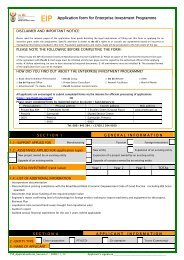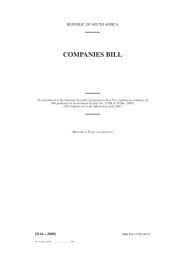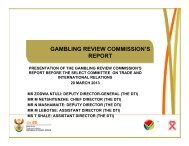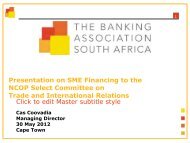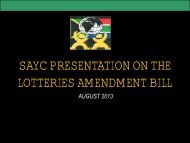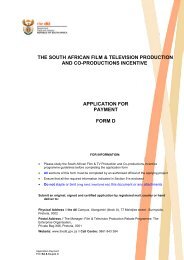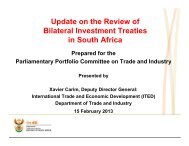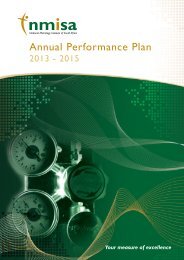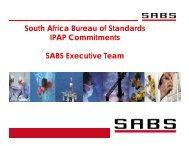Copyright Review Commission Report - ICT Law and Regulation ...
Copyright Review Commission Report - ICT Law and Regulation ...
Copyright Review Commission Report - ICT Law and Regulation ...
- No tags were found...
Create successful ePaper yourself
Turn your PDF publications into a flip-book with our unique Google optimized e-Paper software.
1.4.9. The CRC derived considerable benefit from the reports of three foreign commissions that dealt in recent yearswith copyright issues, namely:1.4.9.1. The <strong>Review</strong> of Australian <strong>Copyright</strong> Collecting Societies, a report made in 1995 to the Australian Ministersfor Communications <strong>and</strong> Arts <strong>and</strong> Justice by Mr Shane Simpson (the Simpson <strong>Report</strong>);1.4.9.2. The Gowers <strong>Review</strong> of Intellectual Property, a review commissioned by the British Chancellor of theExchequer <strong>and</strong> the Secretaries of State for Trade <strong>and</strong> Industry <strong>and</strong> Culture, Media <strong>and</strong> Sport, written by MrAndrew Gowers <strong>and</strong> published in December 2006 (the Gowers <strong>Review</strong>); <strong>and</strong>1.4.9.3. Digital Opportunity, a <strong>Review</strong> of Intellectual Property <strong>and</strong> Growth, an Independent <strong>Report</strong> by Professor IanHargreaves, commissioned by the British Prime Minister <strong>and</strong> published in May 2011 (the Hargreaves<strong>Report</strong>).2 THE FACTUAL BACKGROUND2.1 PRE-1994 NEEDLETIME ASSESSMENT2.1.1. In September 1992, the then Deputy Minister of Trade <strong>and</strong> Industry, Mr D Graaff, MP, referred the questions ofneedletime <strong>and</strong> a blank tape levy to the St<strong>and</strong>ing Advisory Committee, appointed in terms of Section 40 of the<strong>Copyright</strong> Act of 1978, of which the chairperson was the Honourable Mr Justice LTC Harms. The relevantproposals were made by the Association of the South African Music Industry (ASAMI). According to theCommittee’s report, it disagreed with ASAMI that the right to needletime was taken away in 1965 becauseParliament succumbed to pressures from the SABC. They attributed the removal of needletime to “the allegedexisting abuse of rights <strong>and</strong> an intractable attitude of the record industry to agree to a reasonable royalty rate”(the St<strong>and</strong>ing Advisory Committee on the <strong>Copyright</strong> Act, <strong>Report</strong> on ‘Needle Time’ <strong>and</strong> ‘Blank Tape Levy’, 1993).According to the report, the broadcasters had presented the argument against needletime that the promotionalvalue of broadcasting was sufficient compensation in lieu of a royalty. ASAMI, on the other h<strong>and</strong>, argued thatthe promotional value could be taken into account when a licence was negotiated. The Statutory AdvisoryCommittee concluded that although much was to be said for needletime, a recommendation could not be madeunless a number of matters were cleared up, including: whether performers should share in the income; what the financial implications would be for smaller broadcasters; whether it would hamper the freeing of the airwaves; what the financial implications would be for the country; how performers would gain <strong>and</strong> how much; <strong>and</strong> whether the introduction of needletime should not await developments in the US <strong>and</strong> at WIPO, an agencyof the United Nations (UN), which negotiates <strong>and</strong> manages the various intellectual property (IP) treaties.- 10 -



